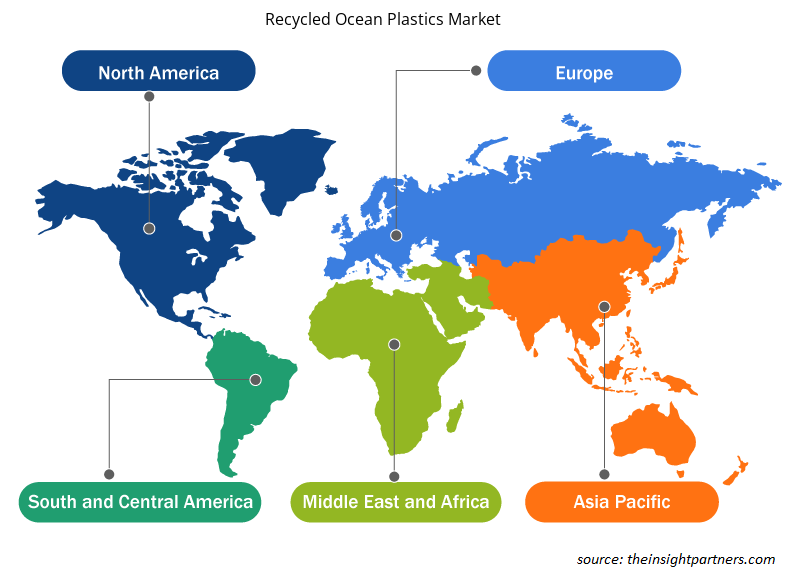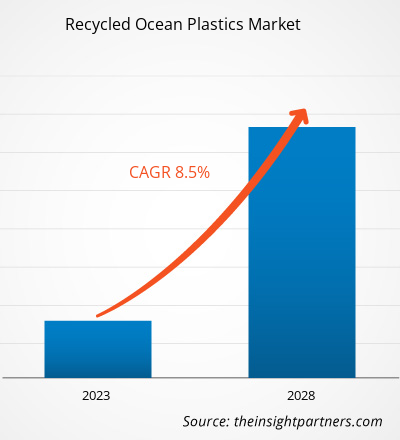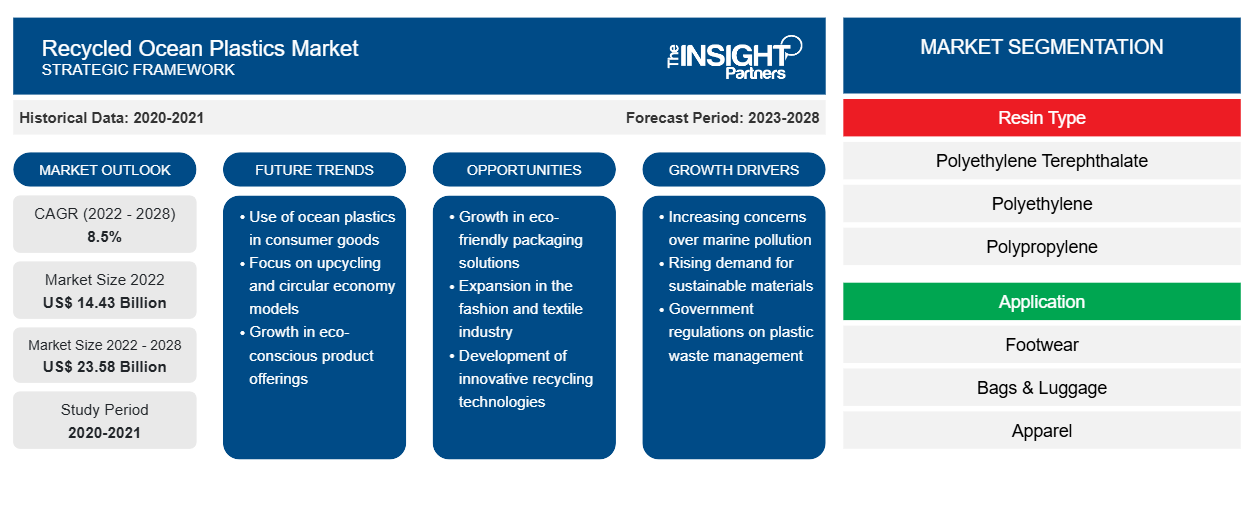Nel 2022 il mercato della plastica riciclata dagli oceani aveva un valore stimato di 14.432,91 milioni di dollari e si prevede che crescerà a un CAGR dell'8,5% dal 2022 al 2028.CAGR of 8.5% from 2022 to 2028.
L'inquinamento da plastica è una delle principali preoccupazioni a causa del suo impatto negativo sugli organismi viventi. Ogni anno, tonnellate di rifiuti di plastica vengono scaricati negli oceani e nei corsi d'acqua, il che ostacola l'ecosistema marino. Quindi, i produttori si stanno concentrando in modo significativo sul riciclaggio dei rifiuti di plastica oceanica e sulla produzione di prodotti utili come calzature, borse, valigie, portafogli e vestiti da queste plastiche.
Nel 2021, l'Asia Pacifica ha detenuto la quota di fatturato maggiore del mercato globale della plastica oceanica riciclata . Il mercato nell'Asia Pacifica è segmentato in India, Cina, Australia, Giappone, Corea del Sud e resto dell'Asia Pacifica. La crescita del mercato della plastica oceanica riciclata nella regione è guidata dalla rapida espansione dell'industria della moda, dall'aumento della popolazione e dalla crescente consapevolezza dei consumatori sulle soluzioni sostenibili in tutta la regione. Cina e India sono tra i paesi con la popolazione in più rapida crescita. A causa della crescita della popolazione, i settori delle calzature, degli imballaggi e delle costruzioni si stanno sviluppando rapidamente nella regione. Le crescenti iniziative dei produttori regionali per ridurre l'impronta di carbonio producendo prodotti ecocompatibili alimentano anche la crescita del mercato della plastica oceanica riciclata nella regione.eco-friendly products also fuel the recycled ocean plastics market growth in the region.
Personalizza questo report in base alle tue esigenze
Riceverai la personalizzazione gratuita di qualsiasi report, comprese parti di questo report, o analisi a livello nazionale, pacchetto dati Excel, oltre a usufruire di grandi offerte e sconti per start-up e università
-
Scopri le principali tendenze di mercato in questo rapporto.Questo campione GRATUITO includerà analisi di dati che spaziano dalle tendenze di mercato alle stime e alle previsioni.
Impatto della pandemia di COVID-19 sul mercato della plastica oceanica riciclata
La crescente richiesta di materiali sostenibili e rispettosi dell'ambiente da parte dei settori calzaturiero, dell'abbigliamento, degli imballaggi e delle costruzioni stava guidando la domanda di plastica oceanica riciclata prima dell'inizio della crisi pandemica del COVID-19. Tuttavia, nel 2020, i governi di vari paesi hanno imposto dei lockdown per controllare la diffusione dell'infezione da SARS-CoV-2, che hanno interrotto le operazioni delle unità di riciclaggio della plastica, causando una carenza di plastica oceanica riciclata. Secondo un rapporto pubblicato da GA Circular, l'80% delle unità di riciclaggio in India, Vietnam e Filippine è stato chiuso durante i primi mesi del 2020, il che ha causato una significativa carenza di plastica riciclata . Ciò ha avuto un impatto negativo sulla crescita del mercato della plastica oceanica riciclata.
Nel 2021, molte economie hanno ripreso le loro attività. I governi di vari paesi hanno allentato le restrizioni precedentemente imposte e hanno consentito ai produttori di operare a piena capacità. Questo fattore ha avuto un impatto positivo sulle attività di riciclaggio della plastica. Molti governi e ONG stanno costruendo una solida infrastruttura di gestione dei rifiuti per supportare l'economia circolare e ridurre al minimo la minaccia dei rifiuti di plastica sugli ecosistemi marini. Questo fattore stimolerebbe la domanda di plastica oceanica riciclata durante il periodo di previsione.
Approfondimenti di mercato
Aumento del lancio di prodotti realizzati con plastica oceanica riciclata
L'inquinamento da plastica è una sfida globale urgente a causa della significativa minaccia che rappresenta per gli organismi viventi. Secondo le statistiche fornite da Ocean Literacy Portal dall'Organizzazione delle Nazioni Unite per l'educazione, la scienza e la cultura; i rifiuti di plastica rappresentano circa l'80% dell'inquinamento marino totale e circa 8-10 milioni di tonnellate metriche (MMT) di plastica finiscono nell'oceano ogni anno. Inoltre, si prevede che il volume di microplastiche negli oceani aumenterà in modo significativo in futuro. Tuttavia, la consapevolezza riguardo all'inquinamento da plastica negli oceani è aumentata in molti paesi e governi e organismi di regolamentazione stanno prendendo iniziative per riciclare questa plastica. Molte aziende stanno lanciando prodotti innovativi e attraenti, come calzature, borse e portafogli, occhiali da sole e abbigliamento, utilizzando plastica oceanica riciclata per raggiungere i loro obiettivi di sostenibilità e ridurre il loro impatto ambientale complessivo. Tutti questi fattori menzionati guidano la crescita del mercato della plastica oceanica riciclata.
Informazioni sul tipo di resina
In base al tipo di resina, il mercato globale delle plastiche oceaniche riciclate è segmentato in polietilene tereftalato (PET) , polietilene (PE), polipropilene (PP), polistirene (PS) e altri. Il segmento del polietilene tereftalato ha detenuto la quota maggiore del mercato nel 2021. La facilità di estrazione del polietilene tereftalato (PET) dagli oceani e dai corsi d'acqua grazie al suo peso maggiore e alla capacità di mantenere la sua forma sta rafforzando la crescita del mercato nel segmento. Inoltre, anche la crescente domanda di PET oceanico riciclato per applicazioni di borse, valigie e calzature sta guidando la crescita del mercato nella regione.
Approfondimenti sulle applicazioni
In base all'applicazione, il mercato globale della plastica oceanica riciclata è segmentato in calzature, borse e valigie, abbigliamento, materiali da costruzione e altri. Il segmento dell'abbigliamento ha detenuto la quota di mercato maggiore nel 2021. Si prevede che la crescente domanda di abbigliamento da parte dell'industria della moda e la crescente popolazione globale determineranno la necessità di plastica oceanica riciclata nell'industria tessile nei prossimi anni.
Aquafil SpA; BIONIC; Tide Ocean SA; Oceanworks; Textil Santanderina; Envision Plastics; OceanYarn; Waste2Wear; Unifi, Inc.; e SABIC sono tra i player che operano nel mercato della plastica oceanica riciclata. Queste aziende stanno effettuando investimenti significativi in R&S per sviluppare prodotti innovativi per soddisfare le esigenze emergenti dei consumatori. I player del mercato si concentrano sulla fornitura di prodotti di alta qualità per soddisfare la domanda dei clienti.
Approfondimenti regionali sul mercato della plastica oceanica riciclata
Le tendenze regionali e i fattori che influenzano il mercato della plastica oceanica riciclata durante il periodo di previsione sono stati ampiamente spiegati dagli analisti di Insight Partners. Questa sezione discute anche i segmenti e la geografia del mercato della plastica oceanica riciclata in Nord America, Europa, Asia Pacifico, Medio Oriente e Africa e America meridionale e centrale.

- Ottieni i dati specifici regionali per il mercato della plastica oceanica riciclata
Ambito del rapporto sul mercato della plastica oceanica riciclata
| Attributo del report | Dettagli |
|---|---|
| Dimensioni del mercato nel 2022 | 14,43 miliardi di dollari USA |
| Dimensioni del mercato entro il 2028 | 23,58 miliardi di dollari USA |
| CAGR globale (2022 - 2028) | 8,5% |
| Dati storici | 2020-2021 |
| Periodo di previsione | 2023-2028 |
| Segmenti coperti |
Per tipo di resina
|
| Regioni e Paesi coperti |
America del Nord
|
| Leader di mercato e profili aziendali chiave |
|
Densità degli attori del mercato della plastica oceanica riciclata: comprendere il suo impatto sulle dinamiche aziendali
Il mercato della plastica oceanica riciclata sta crescendo rapidamente, spinto dalla crescente domanda degli utenti finali dovuta a fattori quali l'evoluzione delle preferenze dei consumatori, i progressi tecnologici e una maggiore consapevolezza dei benefici del prodotto. Con l'aumento della domanda, le aziende stanno ampliando le loro offerte, innovando per soddisfare le esigenze dei consumatori e capitalizzando sulle tendenze emergenti, il che alimenta ulteriormente la crescita del mercato.
La densità degli operatori di mercato si riferisce alla distribuzione di aziende o società che operano in un particolare mercato o settore. Indica quanti concorrenti (operatori di mercato) sono presenti in un dato spazio di mercato in relazione alle sue dimensioni o al valore di mercato totale.
Le principali aziende che operano nel mercato della plastica oceanica riciclata sono:
- Aquafil SpA
- BIONICO
- Marea Oceano SA
- Lavori oceanici
- Tessile Santanderina
Disclaimer : le aziende elencate sopra non sono classificate secondo un ordine particolare.

- Ottieni una panoramica dei principali attori del mercato della plastica oceanica riciclata
Segnala i riflettori
- Tendenze industriali progressive nel mercato della plastica oceanica riciclata per aiutare gli operatori a sviluppare strategie efficaci a lungo termine
- Strategie di crescita aziendale adottate dai mercati sviluppati e in via di sviluppo
- Analisi quantitativa del mercato della plastica oceanica riciclata dal 2020 al 2028
- Stima della domanda globale di plastica oceanica riciclata
- Analisi delle cinque forze di Porter per illustrare l'efficacia degli acquirenti e dei fornitori che operano nel settore
- Sviluppi recenti per comprendere lo scenario competitivo del mercato
- Tendenze e prospettive di mercato, nonché fattori che guidano e frenano la crescita del mercato della plastica oceanica riciclata
- Assistenza nel processo decisionale evidenziando le strategie di mercato che sostengono l'interesse commerciale, portando alla crescita del mercato della plastica oceanica riciclata
- La dimensione del mercato della plastica oceanica riciclata in vari nodi
- Panoramica dettagliata e segmentazione del mercato, nonché dinamiche del settore della plastica oceanica riciclata
- Dimensioni del mercato della plastica oceanica riciclata in varie regioni con promettenti opportunità di crescita
Mercato globale della plastica oceanica riciclata
Il mercato globale della plastica oceanica riciclata è segmentato in base al tipo di resina in polietilene tereftalato (PET), polietilene (PE), polipropilene (PP), polistirene (PS) e altri. Per applicazione, il mercato è segmentato in calzature, borse e valigie, abbigliamento, materiali da costruzione e altri.
Profili aziendali
- Aquafil SpA
- BIONICO
- Marea Oceano SA
- Lavori oceanici
- Tessile Santanderina
- Immagina la plastica
- Filato oceanico
- Rifiuti2Indossare
- Unifi, Inc.
- SABIC amore
- Analisi storica (2 anni), anno base, previsione (7 anni) con CAGR
- Analisi PEST e SWOT
- Valore/volume delle dimensioni del mercato - Globale, Regionale, Nazionale
- Industria e panorama competitivo
- Set di dati Excel
Report recenti
Rapporti correlati
Testimonianze
Motivo dell'acquisto
- Processo decisionale informato
- Comprensione delle dinamiche di mercato
- Analisi competitiva
- Analisi dei clienti
- Previsioni di mercato
- Mitigazione del rischio
- Pianificazione strategica
- Giustificazione degli investimenti
- Identificazione dei mercati emergenti
- Miglioramento delle strategie di marketing
- Aumento dell'efficienza operativa
- Allineamento alle tendenze normative























 Ottieni un campione gratuito per - Mercato della plastica oceanica riciclata
Ottieni un campione gratuito per - Mercato della plastica oceanica riciclata